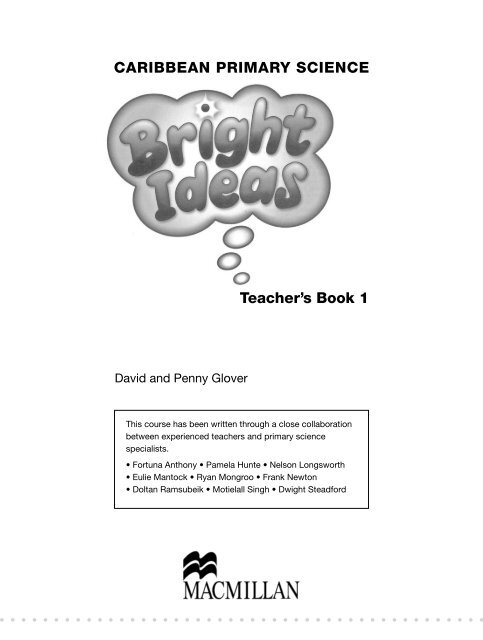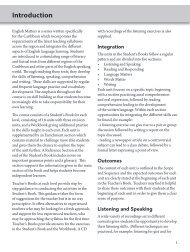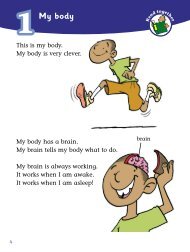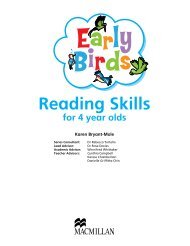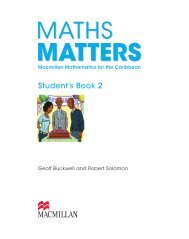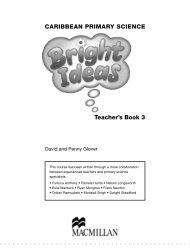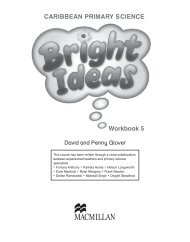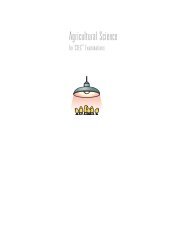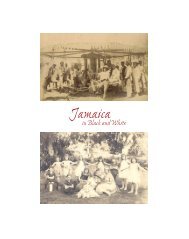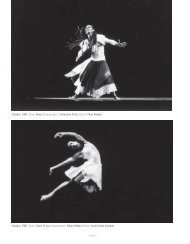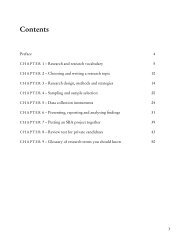CARIBBEAN PRIMARY SCIENCE Teacher's Book 1 - Macmillan ...
CARIBBEAN PRIMARY SCIENCE Teacher's Book 1 - Macmillan ...
CARIBBEAN PRIMARY SCIENCE Teacher's Book 1 - Macmillan ...
You also want an ePaper? Increase the reach of your titles
YUMPU automatically turns print PDFs into web optimized ePapers that Google loves.
<strong>CARIBBEAN</strong> <strong>PRIMARY</strong> <strong>SCIENCE</strong>Teacher’s <strong>Book</strong> 1David and Penny GloverThis course has been written through a close collaborationbetween experienced teachers and primary sciencespecialists.• Fortuna Anthony • Pamela Hunte • Nelson Longsworth• Eulie Mantock • Ryan Mongroo • Frank Newton• Doltan Ramsubeik • Motielall Singh • Dwight SteadfordBITB1_prelims(1-27).indd 111/23/10 6:06:00 PM
ContentsIntroduction 5What is science? 5Why teach science in the primary school? 6The primary science curriculum 7Using Bright Ideas with your curriculum 8Lesson planning 9Resources for science teaching 13Songs, poetry, raps and rhymes 15Field work and visits 15Displays 17Assessing children’s progress in science 17Developing children’s scientific vocabulary 18Developing science process skills 18Science process skills in Bright Ideas 25Safety 25Lesson plans 28Unit 1 My body 28Unit 2 Living things 36Unit 3 My world 51Unit 4 Structures and materials 62Unit 5 Forces and energy 72ResourcesBright Ideas Workbook 1 answers 83Action songs and rhymes for Year 1 Science 89Planning grids 92Bright Ideas Year 1 Scope and sequence 95BITB1_prelims(1-27).indd 311/23/10 6:06:01 PM
Series preface – Bright IdeasThe Bright Ideas series is a comprehensive science course for all students in primary schools.Building on practical experience and investigation, the books follow current best practice inscience education. Through engaging content and carefully graded activities and exercises,students are guided to develop a sound framework of scientific knowledge, understanding andskills. There are seven full-colour Student’s <strong>Book</strong>s from kindergarten level to the final year ofprimary school. Each Student’s <strong>Book</strong> is accompanied by a Workbook.This Teacher’s <strong>Book</strong> provides detailed support for teachers using the Year 1 Student’s <strong>Book</strong> as thebasis for their science teaching through the school year. The introduction starts with a discussionof the question ‘What is science?’ and sets out the case for teaching investigative science in theprimary school. Subsequent sections deal in turn with the primary science curriculum; matchingthe content of Bright Ideas to your curriculum; lesson planning and preparation; resources forscience teaching; field work and visits; displays; assessment; developing science process skills;and safety in science teaching.Pages 28–82 of the guide present sample lesson plans for each of the 42 lessons in the Student’s<strong>Book</strong>s. Each lesson plan lists the lesson objectives and the resources required. There are ideasfor starter activities and lesson development and suggestions for summarising and evaluating thelesson. There are also suggestions for extension activities, cross-curriculum links and answers tothe Student’s <strong>Book</strong> questions.On pages 92–94 you will find printable grids and planning forms to assist your planning andrecord keeping.Science teaching, especially when it is ‘hands-on’, can be highly enjoyable and rewarding forteachers and students alike. We hope that the Bright Ideas course will contribute both to theeffectiveness of your teaching and to the pleasure that you and your class gain from studyingscience.David and Penny GloverBITB1_prelims(1-27).indd 411/23/10 6:06:01 PM
IntroductionWhat is science?For most of history, science had little to do with the everyday lives of ordinary people. This is nottrue today. From antibiotics and X-rays, through mobile phones and the internet, to hurricanetracking by satellite and the impact of global warming – the discoveries and applications ofscience affect all our lives. Indeed, it would not be unreasonable to claim that science has createdthe modern world.So what exactly is science? A partial answer to this question is that science is the body ofknowledge – observations, ideas and explanations – assembled by scientists through generationsof painstaking investigation of the natural world. This knowledge is recorded in books and journalsthat fill miles of shelving in the world’s great libraries. Subdivided into major subject areas such asPhysics, Chemistry, Biology, Geology and Astronomy, the creation of this intellectual wealth is awonderful human enterprise that continues today at an ever increasing rate.Great as this enterprise is, if that’s all there was to science then, apart from the small percentageof the population who work as professional scientists, most of us could only ever hope to bespectators to the discoveries of science and consumers of its applications. But this is certainly notthe case. We can all think and work as scientists; even five-year-olds in their first year at schoolcan be scientists as they discover the wonders of the world in which they live.That this is so is because science is not just a body of knowledge, it is also a process forinvestigating and understanding the things around us and for checking that our ideas andexplanations are correct. The essence of the scientific method is simply stated. Scientificunderstanding is based on:● evidence collected from the real world● careful observations and measurements that can be checked by others● explanations (theories) that make predictions which can be tested by further observation andexperiment.Other key features of the scientific way of thinking and working include important attitudestowards knowledge and learning:● questioning – constant curiosity about how and why things are as they are● respect for evidence – including the willingness to change accepted views of the world whennew evidence contradicts previously held ideas or beliefs● collaboration – working with others, sharing ideas and resources to make new discoveries andto solve problems.The scientific method and attitudes are thus not only relevant to the work of high-poweredprofessors in sophisticated laboratories – they have a role in most aspects of life. Whether it is ahouseholder trying to reduce energy bills, a car driver trying to work out why his or her car won’tstart, a local politician trying to solve the problems of waste disposal in a community, or countlesssimilar challenges we face in our working and daily lives, thinking scientifically has proved to bethe most reliable and efficient method for solving practical problems, as well as for discoveringnew knowledge.BITB1_prelims(1-27).indd 511/23/10 6:06:01 PM
I N T R O D U C T I O NWhy teach science in the primary school?A generation ago science was not commonly taught as a separate subject in primary schools.At best, there would be some nature study and a few model-making activities – which mightexpose children to some simple applications of science in technology – but investigations andexperiments were not on the menu until secondary school and, even then, the emphasis wasoften more on learning about science, rather than learning to do science.With the move away from the didactic ‘chalk-and-talk’ approach to education, towards a morechild-centred model of learning that took place from the 1960s onwards, science gradually tookits place in the primary curriculum. Experiments with discovery learning and new educationaltheories, which emphasised the importance of children ‘constructing’ their own understandingthrough first-hand experiences and by sharing their ideas with others, developed in parallelwith the growing influence of science and technology in society. As politicians recognised theimportance of science education for economies and society in general, educators discovered thevalue of the hands-on approach to science in motivating and enhancing children’s intellectualdevelopment in the primary school.Investigative science motivates andpromotes real learningToday, the case for teaching primary science hardly needs to be stated. Science, alongsidenumeracy and literacy, is a core component of the primary school curriculum in schools aroundthe world. The reasons for teaching science at the primary level may be summarised as follows:● investigation-based science learning develops children’s curiosity, problem solving, practicaland communication skills● basic scientific knowledge of the human body, diet, living things, the environment, materials,forces and energy contributes to children’s developing awareness of themselves and theirrelationship to their surroundings; this knowledge will help them to make healthy choices, tokeep safe and to solve problems as they move through life● scientific values and attitudes such as respect for evidence, questioning, flexible thinking andthe willingness to share knowledge and ideas are relevant in all areas of children’s learning, notjust science● through science, children become aware of environmental issues and the impact that theyas individuals can have on their surroundings; they develop respect for living things and theirenvironment and become aware of the harm that simple actions such as littering, wastingenergy or contaminating water supplies can cause● in the majority of countries science is an examination subject at the end of the final year ofprimary school. Children may need to perform well in science to gain a place at the secondaryschool of their choiceBITB1_prelims(1-27).indd 611/23/10 6:06:02 PM
I N T R O D U C T I O N● a good knowledge of science gained in the primary school prepares children to do well in theirmore formal science education at secondary school. Good results in secondary school scienceexaminations open up a wide range of career opportunities.The primary science curriculumA preliminary reading of primary science curriculum documents from the countries of theCaribbean Region and beyond suggests that each is highly individual, with less in commonbetween the specifications from different countries than for, say, numeracy and literacy.However, a more thorough analysis shows that, although different topics may be tackled indifferent years and there are some country-specific contexts and examples through whichscience is taught, the majority of themes are common to all primary science syllabus documents.Table 1 identifies the core science themes that almost invariably appear at different points in thekindergarten and the six years of primary school.Table 1 Themes common to the majority of primary science syllabusesTheme 1How science worksTheme 2The human bodyTheme 3Plants and animalsTheme 4The environmentTheme 5The Earth and its featuresTheme 6Materials and their propertiesTheme 7Forces and energyTheme 8SpaceScientific enquiry and investigation skills: observing, questioning,classifying, measuring, planning; hypothesising, evaluation, concluding,etc.Body parts and processes: senses and sense organs, health andhygiene, growth, reproduction, organs and organ systems, digestion,nutrition, disease, healthy lifestyles, etc.Living things: classification, variety, body parts and systems, lifeprocesses, interactions, life cycles, photosynthesis, useful plants andanimals, caring for animals, gardening, etc.Habitats and ecosystems: interdependence, different ecosystems,threats to the environment, pollution, deforestation, global warming,endangered species, sustainable development, etc.The structure and components of the Earth: characteristics of rocks andsoil, rock and soil formation, minerals and their uses, landforms, theatmosphere, weather conditions, climate, water supply, the water cycle,natural disasters, etc.Properties and uses of materials: wood, plastic, metal, glass, etc.,matching materials to their applications, conductors and insulators,shaping materials, using tools, natural and synthetic materials, simplestructures, etc.Force, energy and movement: the effects of forces, types of force,friction, gravity, simple machines, energy types and sources, fossil fuelsand global warming, alternative energy sources, the characteristics anduses of heat, light and sound, sources and uses of electricity, simplecircuits, magnetism and its applications, etc.The Earth in space: the Earth, the Sun and the Moon, day and night, theseasons, the tides, the phases of the Moon, eclipses, the solar system,characteristics of the planets, space travel, stars and galaxies, theUniverse, etc.In practice, each theme is revisited several times as children progress through the school.Topics from a given theme, the human body, for example, are taught in different year groups– both as the syllabus demands and as the children become ready to deal with the topic at thedepth required. The main external parts of the human body will probably be introduced in thekindergarten, but the internal organs and their detailed functions will probably not be covered untilBITB1_prelims(1-27).indd 711/23/10 6:06:03 PM
I N T R O D U C T I O NYears 5 or 6. Children progress at different rates and so the opportunity to revisit a topic gives thechance to reinforce and develop understanding; a topic which had been only partly understood inan earlier year may be grasped more fully when it is met again and taken further in later years.plants Y6 animals human energy body: spacematerials Earth digestive ecosystemsmagnetism Y5 electricity plantsanimals energy human space body: forcematerials Earth ecosystemsY4internal organsmagnetism electricity plantsanimals energy human space body: forcematerials Y3 Earth diet and ecosystems healthmagnetism electricity plantsanimals Y2 energy human space body: forcematerials Earth growth ecosystemsmagnetism Y1 electricity plantsanimals energy human space body: forcematerials Earth ecosystemsKexternal partsThe spiral curriculum. Progression through the primaryscience curriculum is more akin to a spiral than a straightline. Children revisit ideas and take them to a higher level asthey progress up the learning spiral.Themes 2–8 in Table 1 are the knowledge-based areas of the curriculum – the traditional ‘content’of science. As children work on these themes they learn the basic facts of science – facts aboutliving things, materials, energy, the planets and so on, but they should not be passive absorbers offacts. Learning is more effective when learners are actively engaged with the topic: planning andcarrying out investigations, participating in discussions, using the library or the internet to conductresearch for a poster or a display. It is Theme 1 ‘How science works’ that is concerned with theprocesses, skills and attitudes of science. As children put these skills into practice, they becomescientists themselves and the syllabus content is brought to life.In some syllabus documents, science skills are listed in the overall aims of the course; in othersthey may be set out as a separate set of objectives in a section similar to the objectives for theknowledge-based themes. Wherever they appear in the syllabus, it is important we recognise thatscience skills cannot be taught in isolation, but should be introduced in real contexts. The ideaof a ‘fair test’, for example, might be introduced when children compare the conditions in whichseeds germinate in Years 1 or 2. The concept of fairness can then become part of investigations inall parts of the curriculum.Using Bright Ideas with your curriculumThe Bright Ideas course has been written for use throughout the Caribbean Region. In developingthe course, syllabus documents from around the region were examined to select the topics forinclusion. Our aim has been to produce a comprehensive course which includes all the topics ateach level that teachers will need to satisfy their syllabus requirements. This means that:● each Student’s <strong>Book</strong> contains more material than will be required for any one syllabus● teachers must select the material they need for their syllabus● ‘extra’ material is available in each book for extension and enrichment.BITB1_prelims(1-27).indd 811/23/10 6:06:04 PM
I N T R O D U C T I O NThe Student’s <strong>Book</strong>s have been structured to make the selection task as straightforward aspossible. The content has been carefully broken down into self-contained two or three page‘lessons’. The lessons are grouped as subject Units.Each lesson includes the following elements:● list of lesson objectives● main content illustrated with artwork and/or photographs● one or more activities (these are a mixture of experiments, group work and pencil-and-paperactivities)● one or more fascinating fact boxes● key words● a copy-and-complete summary of key learning points● two or three review questions.The learning objectives for each lesson are clearly stated in the Student’s <strong>Book</strong>s in the boxfollowing the lesson title. For example, for Unit 1, Lesson 1 of Year 1:My heartOBJECTIVESWhen you have completed this lesson you will be able to:● point to your heart● feel your heart beatThe knowledge and skills areas supported by the lesson are summarised in the scope andsequence table at the back of the Student’s <strong>Book</strong> and Teacher’s <strong>Book</strong>. For example:Lesson Title Science Knowledge Science SkillsUNIT 1 MY BODYMy heartLocation of the heart in the bodyThe heartbeatusing the senses to observe;experimentingTo assist your planning, all this information is brought together as a series of printable planninggrids at the back of this guide. You can use copies of the planning grids together with yoursyllabus document to identify those lessons you will be teaching through the school year. Use theblank columns in the grids to add additional comments and information as required.Lesson planningThe Student’s <strong>Book</strong> provides the basis for individual lessons, with the core content, activities andquestions to reinforce and review the students’ learning. Occasionally you may wish to base anentire lesson around book-work, but science lessons would be dull and repetitive if they wereall taught ‘by-the-book’. In general, lessons should be individually planned, with a variety ofresources used alongside the book. At various stages of the lesson, students may be engaged indiscussion with each other and/or the teacher, question-and-answer, practical work, observingdemonstrations, drawing or note making, answering written questions, reciting poems andrhymes, singing and other activities (though not necessarily all of the above in any one lesson!)BITB1_prelims(1-27).indd 911/23/10 6:06:05 PM
I N T R O D U C T I O NThe key to a good lesson is good planning. The form below is an outline lesson plan for a sciencelesson. The sections have been completed with explanations of the kinds of activities the teacherand the children should be engaged in at different points in the lesson. A blank lesson plan formis available on page 92 for you to photocopy. Pages 28–82 of this Teacher’s <strong>Book</strong> present samplelesson plans for each of the topics in the Year 1 Student’s <strong>Book</strong>.Outline science lesson planSubject: Science Year 1Date: The date taughtTheme: The lesson theme, for example, My bodyTitle: The specific lesson title, for example, Keeping cleanSyllabus objectives: The syllabus objective(s) the lesson is planned to cover; for example,show how to keep their bodies cleanKnowledge and skills: The science knowledge and skills the lesson develops, for example,the importance of hygiene; keeping the body clean; participating in discussion; explainingproceduresResources: Resources required to teach the lesson, which should be prepared in advance;for example, examples of cleaning materials including soap, shampoo, nail brush, bowls ofwater, etc.Lesson introductionThis is the first part of the lesson in which the teacher revises previous work and introducesthe new topic. It is important to engage the children’s interest and imagination at the outsetof the lesson. Discussion of specimens and/or the children’s own experiences and existingknowledge is a good way to do this. For example, the teacher might start the lesson byasking children to point to and name their body parts. They could sing the ‘Head, Shoulders,Knees and Toes’ rhyme.The teacher then proceeds to introduce new ideas, perhaps through observations of specimensbrought into the classroom. For a ‘Keeping clean’ lesson, the teacher could ask the children toexamine their own hands, nails and faces to see if they are clean. Where appropriate, new ideascan be introduced through reference to pictures and text in the Student’s <strong>Book</strong>.Lesson developmentThis is the main part of the lesson in which the students are engaged in activities andinvestigations. For example - show the students the cleaning materials you have brought intoclass. Or look at those illustrated in the Student’s <strong>Book</strong>. Ask the children to work in smallgroups to role-play (act out) how they would use each of the items to clean their bodies.Evaluation and summaryIn this part of the lesson the students report their observations and conclusions and theteacher helps them to state the results by introducing appropriate new vocabulary. ‘This ishow we wash our hands with soap and water. This is how we scrub our nails with a brush.Washing and scrubbing cleans away dirt.’ The teacher summarises the lesson content,if appropriate making sketches or writing new vocabulary on the board. The ‘Check yourprogress’ questions in the Student’s <strong>Book</strong> could be used at this stage. The teacher may1 0BITB1_prelims(1-27).indd 1011/23/10 6:06:05 PM


